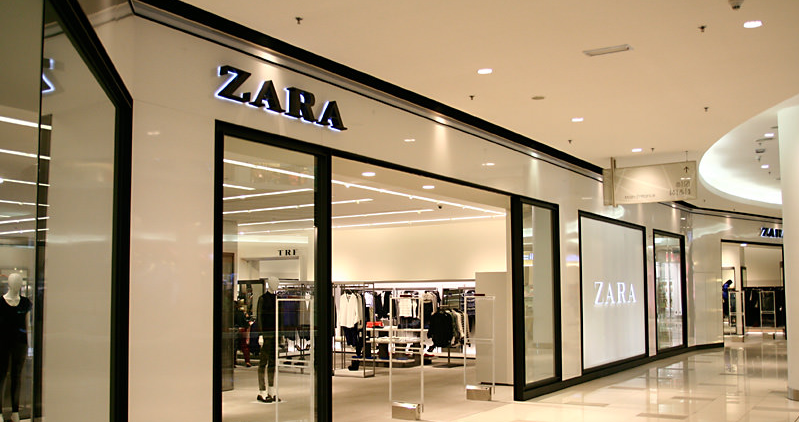Described as a company that will ‘change retail scenario forever’, Zara has revolutionized the world of fashion by bringing out a large number of collections each season, instead of the same old two collections every year.
Zara is one of the largest Spanish clothing and accessories retailer based in Arteixo, Galecia, founded in 1975 by Amancio Ortega and Rosalia Mera. The first store provided the customers with low- priced products, this gained popularity and became successful, that’s how a chain of stores was opened throughout Spain. Zara is a vertically integrated retailer, controlling the design, supply chain, distribution and manufacturing of its products worldwide. It has 6,500 stores across 88 countries.
Unfolding Zara’s Business Model:
Zara produces where it sells and utilizes a very tight supply chain from initial design through to final production. This allows the company adapt to new fashion trends and ideas within two weeks. As a result, short lead times for new products and fast replenishes of sold-out merchandise, are being made possible.
Zara manages to design, produce, distribute and sell its collections in a mere four weeks.
Business and Strategy:
Zara uses a push-based model which means factories push out product to stores which is then sold to consumers; there is no customization or products being made to order.
Also, termed as a ‘Fast Fashion’ model, Zara’s business strategy is simple and straight. The main agenda is to roll-over the inventory at such a fast pace that customers are actually scared that if they like anything and didn’t buy it immediately, it will not stay till the next visit.
Tip: Never thought of doing window shopping at Zara outlets, you might end up losing your favourite crop top. Take ample amount of money with you…
They maintain this continuous loop:
- Fashion Spotting Based on New Trends
- Design
- Production in factories
- Ship to stores
- Sell to Consumers
- REPEAT
Production and Supply Strategy:
Zara has limited production seasons and a high turnover of products. They change every 15 days. So, Zara manages to save on its warehousing and inventory costs in every shop worldwide.
The designer team has over 200 professionals, 12,000 different models for the sale in stores. Zara adopts a centralized distribution system, where garments (in-house and purchased from vendors) arrives at Zara’s warehouses in Spain, and then delivered worldwide.
Design Strategy:
Instead of designing a collection long ahead of its release, Zara tries to continuously recognize emerging fashion and incorporate them in its designs and products. Through sales data capture and shopper anecdotal feedback, store managers daily report tens of thousands of customer reactions to design teams. Sale trends are analyzed along to runway releases and quickly incorporated into the next line of production, creating a cycle of iteration and innovation. Once designed, new fashions are produced in relatively small quantities, so “misses” can be quickly identified and discontinued and “hits” built-upon and re-released.
Zara uses Asian manufacturers to produce clothing staples such as plain t-shirts, which are not sensitive to fashion trends and the use of lower-wage labour with larger contracts makes sense.
Promotional Strategy:
Zara does not use advertising to promote its brand, which is uncommon in the retail world. Zara’s success has been achieved without resorting to any advertising campaigns. To spread the word about the company, it depends on word of mouth and on its landmark retail outlets in high-end locations. It spends a meagre 0.3 per cent of sales on advertising compared to an average of 3.5 per cent by competitors.
Location Strategy:
Zara uses its store location and store displays as key elements of its marketing strategy. By choosing to be in the most prominent locations in a city, Zara ensures very high customer traffic for its stores. Its window displays, which showcase the most outstanding pieces in the collection, are also a powerful communication tool designed by a specialized team.
Logistics Strategy:
Distribution takes place twice a week to ensure store inventories are constantly kept fresh and unique. The logistics system ensures that the time between receiving an order at the distribution center to the worldwide delivery of the goods in the store is completed within 2 business days.
Distribution management:
Zara’s state-of-the-art distribution facility functions with minimal human intervention. Optical reading devices sort out and distribute more than 60,000 items of clothing an hour.
Going ‘Tech’ way…
Shoppers can swipe garments along a floor-to-ceiling mirror to see a hologram-style image of what they’d look like as part of a full outfit in Zara’s new flagship store in London.
Moreover, every garment is fitted with a radio-frequency identification tag. The technology lets Zara check a store’s inventory in two hours, a process that used to take about three days.
Robot arms get garments into shoppers’ hands at online-order collection points. iPad-wielding assistants also help customers in the store order their sizes online, so they can pick them up later.
Remember the shopping mall in the movie “Love Story 2050”? Looks like Indians may not have to wait till 2050 to witness the futuristic experiences.
With a very entrepreneurial culture at office, Zara’s brand culture is extremely customer-centric, which has been and continues to be a significant contributor to Zara’s success.



